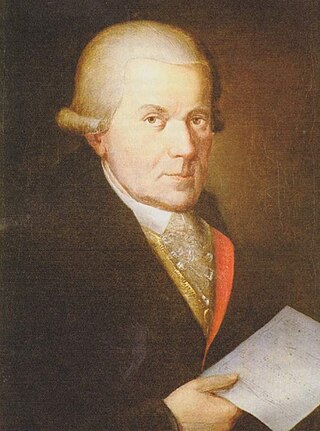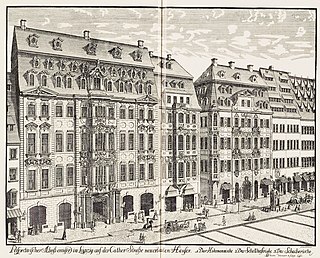The year 1791 in music involved some significant events.

The Symphony No. 37 in G major, K. 444/425a+Anh.A 53, is a symphony misattributed to Wolfgang Amadeus Mozart. It is the P 16, MH 334 – Symphony No. 25 in G major by Michael Haydn with an Adagio maestoso composed and added by Mozart as an introduction. Mozart's added introduction led to the misattribution of the entire symphony being his original work.

Wolfgang Amadeus Mozart's Oboe Concerto in C major, K. 314 (271k), was composed in the spring or summer of 1777, for the oboist Giuseppe Ferlendis (1755–1802) from Bergamo. In 1778, Mozart re-worked it as a concerto for flute in D major. The concerto is a widely studied piece for both instruments and is one of the most important concertos in the oboe repertoire.
The String Quintet No. 4 in G minor, K. 516, written by Wolfgang Amadeus Mozart, is like all of Mozart's string quintets a "viola quintet" in that it is scored for string quartet and an extra viola . The mood of the piece is dark and melancholic, typical of Mozart's G minor works.
The String Quintet No. 3 in C major, K. 515 was written by Wolfgang Amadeus Mozart. Like all of Mozart's string quintets, it is a "viola quintet" in that it is scored for string quartet and an extra viola.

Piano Concerto No. 5 in D major, K. 175, was composed by Wolfgang Amadeus Mozart in 1773, at the age of 17. It is Mozart's first original piano concerto; his previous efforts were based on works by other composers. In 1782, he revised the score and composed a new rondo, adding a flute to the instrumentation.
The Flute Quartet No. 4 in A major, K. 298, by Wolfgang Amadeus Mozart is Mozart's final composition for flute quartet. Unlike the previous three quartets, written for the flutist Ferdinand De Jean, the Quartet in A is believed to have been written for recreational purposes, as opposed to on commission. The low Köchel number is misleading. The work is thought to have been written sometime in 1786 or 1787, only a few years before the composer's death.

Marianne Antonia Kirchgessner, also Mariana Kirchgessner, Kirchgäßner,, was a German glass harmonica player. She was blind from eye disease caused by smallpox when she was four years old. Kirchgessner's artistic qualities brought her the attention of great composers such as Muzio Clementi, Johann Gottlieb Naumann, Johann Friedrich Fasch, Johann Friedrich Reichardt and Franz Anton Hoffmeister.
The Symphony in F major "No. 43", K. 76/42a, was probably written by Wolfgang Amadeus Mozart.
The Symphony in B♭ major "No. 54", K. Anh. 216/74g/Anh.C 11.03, may have been written by Wolfgang Amadeus Mozart in 1771, in Salzburg.

The Symphony in A minor "Odense", K. Anh. 220/16a, was formerly attributed to Wolfgang Amadeus Mozart. If the Odense Symphony had truly been Mozart's, it would be among only three of Mozart's symphonies to be written in a minor key. It is now considered certain that the symphony is not by Mozart.

The Sonata in G major for two flutes and basso continuo, BWV 1039, is a trio sonata by Johann Sebastian Bach. It is a version, for a different instrumentation, of the Gamba Sonata, BWV 1027. The first, second and fourth movement of these sonatas also exist as a trio sonata for organ.
The lost Symphony in C major, K. Anh. 222/19b, was probably written by Wolfgang Amadeus Mozart in early 1765 in London. It is one of the twelve symphonies that Ludwig von Köchel only knew by its incipit in the Breitkopf & Härtel manuscript catalogue, which listed it as one of six symphonies (Nos. 65–70) sourced from Luigi Gatti (1740–1817), Court Kapellmeister in Salzburg from around 1782:

The composition of Mozart's unfinished Requiem, K. 626, his last work, is surrounded by the following events.

Wolfgang Amadeus Mozart composed four litanies in his service as a church musician for the Salzburg Cathedral, two of which are settings of the Litaniae Lauretanae, the Litany of the Blessed Virgin Mary. The other two are settings of the Litaniae de venerabili altaris sacramento, venerating the Eucharist. Mozart composed the works for four soloists, choir, instruments, and continuo. The litanies appeared in Bärenreiter's Neue Mozart-Ausgabe (NMA) in 1969.

Wolfgang Amadeus Mozart's Horn Quintet, K. 407 (386c), was written in 1782 for the soloist Joseph Leutgeb. The work calls for one French horn, one violin, two violas and one cello, differing from the usual two violins with the conventional string quartet.
The Concertone for two Violins and Orchestra in C, K. 190 (186e) was written by Wolfgang Amadeus Mozart in May 1774.







